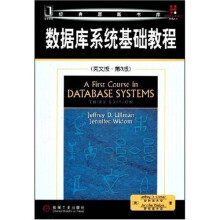华章图书·数据库系统基础教程(英文版)(第3版)
作者:(美)厄尔曼,(美)怀德姆 著
出版:机械工业出版社 2008.8
页数:565
定价:45.00 元
ISBN-13:9787111247333
ISBN-10:7111247337
去豆瓣看看 1 The Worlds of Database Systems
1.1 The Evolution of Database Systems
1.1.1 Early Database Management Systems
1.1.2 Relational Database Systems
1.1.3 Smaller and Smaller Systems
1.1.4 Bigger and Bigger Systems
1.1.5 Information Integration
1.2 Overview of a Database Management System
1.2.1 Data-Definition Language Commands
1.2.2 Overview of Query Processing
1.2.3 Storage and Buffer Management
1.2.4 Transaction Processing
1.2.5 The Query Processor
1.3 Outline of Database-System Studies
1.4 References for Chapter 1
2 Relational Database Modeling
2 The Relational Model of Data
2.1 An Overview of Data Models
2.1.1 What is a Data Model?
2.1.2 Important Data Models
2.1.3 The Relational Model in Brief
2.1.4 The Semistructured Model in Brief
2.1.5 Other Data Models
2.1.6 Comparison of Modeling Approaches
2.2 Basics of the Relational Model
2.2.1 Attributes
2.2.2 Schemas
2.2.3 Tuples
2.2.4 Domains
2.2.5 Equivalent Representations of a Relation
2.2.6 Relation Instances
2.2.7 Keys of Relations
2.2.8 An Example Database Schema
2.2.9 Exercises for Section 2.2
2.3 Defining a Relation Schema in SQL
2.3.1 Relations in SQL
2.3.2 Data Types
2.3.3 Simple Table Declarations
2.3.4 Modifying Relation Schemas
2.3.5 Default Values
2.3.6 Declaring Keys
2.3.7 Exercises for Section 2.3
2.4 An Algebraic Query Language
2.4.1 Why Do We Need a Special Query Language?
2.4.2 What is an Algebra?
2.4.3 Overview of Relational Algeebra
2.4.4 Set Operations on Relations
2.4.5 Projection
2.4.6 Selection
2.4.7 Cartesian Product
2.4.8 Natural Joins
2.4.9 Theta-Joins
2.4.10 Combining Operations to Form Queries
2.4.11 Naming and Renaming
2.4.12 Relationships Among Operations
2.4.13 A Linear Notation for Algebraic Expressions
2.4.14 Exercises for Section 2.4
2.5 Constraints on Relations
2.5.1 Relational Algebra as a Constraint Language
2.5.2 Referential Integrity Constraints
2.5.3 Key Constraints
2.5.4 Additional Constraint Examples
2.5.5 Exercises for Secticn 2.5
2.6 Summary of Chapter 2
2.7 References for Chapter 2
3 Design Theory for Relational Databases
3.1 Functional Dependencies
3.1.1 Definition of Functional Dependency
3.1.2 Keys of Relations
3.1.3 Superkeys
3.1.4 Exercises for Section 3.1
3.2 Rules About Functional Dependencies
3.2.1 Reasoning About Functional Dependencies
3.2.2 The Splitting/Combining Rule
……
4 High-Level Database Models
5 Algebraic and Logical Query Languages
6 The Database Language SQL
7 Constraints and Triggers
8 Views and Indexes
9 SQL in a Server Environment
10 Advanced Topics in Relational Databases
11 The Semistructured-Data Model
12 Programming Languages for XML
Index
Jeffrey D.UIIman斯坦福大学计算机科学系.Stanford W.Ascherman教授,数据库技术专家。他独立或与人合作出版了15本著作,发表了170多篇技术论文。他的研究兴趣包括数据库理论.数据库集成、数据挖掘和利用信息基础设施进行教育。他是美国国家工程院成员,曾获得Knuth奖、SIGMOD贡献奖、Karlstrom杰出教育家奖和Edgar E Codd发明奖。
《华章图书·数据库系统基础教程(英文版)(第3版)》由美国斯坦福大学知名计算机科学家Jeffrey Ullman和Jennifer Widom合作编写。书中介绍了核心DBMS概念、理论和模型,描述了如何使用抽象语言和SQL查询与更新DBMS。在介绍了SQL扩展内容(包括嵌入式SQL程序设计和对象关系特征)后,又介绍了使用XML的系统。设计语言包括XML模式,查询语言包括XPath和XQuery。

